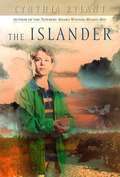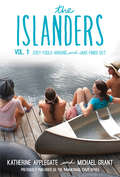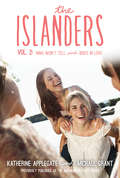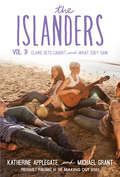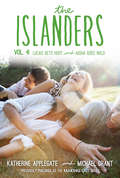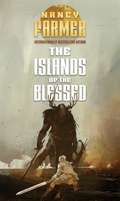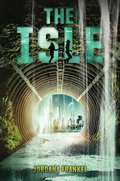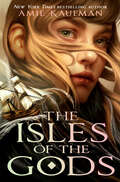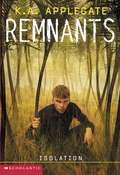- Table View
- List View
The Islander
by Cynthia RylantWhen Daniel's parents die, he goes to live with his grandfather on a remote gray island off British Columbia. Daniel is lonely until he meets a mermaid. When he returns to find her, a sea otter tosses him a shell with key inside. What will this magical key unlock? Written by the Newbery Award-winning author of "Missing May. "
The Islanders: Volume 1
by Katherine Applegate Michael GrantOn a small island it's easy to know everything about your friends . . . except for the truth. The first two books of bestselling authors Katherine Applegate and Michael Grant's beloved series about New England's most unforgettable teens are now available in one volume!Two years ago the tiny New England community on Chatham Island was rocked by tragedy--three teenagers had a terrible accident that left one dead. Now Lucas Cabral, the person responsible for the events on that fateful night, has returned. But life on the island isn't the same, and everyone Lucas once considered a friend refuses to speak to him. Everyone except for Zoey Passmore.Zoey knows that Lucas is off-limits . . . but she can't seem to stay away from him. Even though she knows it would be better for everyone if he had never come back. Even though she is dating Jake, the brother of the boy who died. As Lucas and Zoey grow closer, Zoey risks tearing apart her close-knit group of friends if they discover the truth . . . that she's falling for her boyfriend's worst enemy.Formerly known as Making Out #1: Zoey Fools Around and Making Out #2: Jake Finds Out.
The Islanders: Volume 2
by Katherine Applegate Michael GrantThe Islanders have known one another forever--but everyone has secrets. The third and fourth books in Katherine Applegate and Michael Grant's electrifying series reach a whole new audience in this gorgeous omnibus edition.Nina has never been very interested in having a boyfriend. Especially since the only guy she's ever really liked happens to be dating her sister, Claire. But when Ben and Claire break up, Nina begins to wonder if it's time she take a risk and put her heart on the line. The only problem is the other thing . . . the secret that Nina has never told anyone. The secret that has haunted her for years.Now Nina must decide if she can tell her friends the truth. And, if she does, whether it's possible Ben will ever look at her the same way again.Formerly known as Making Out #3: Nina Won't Tell and Making Out #4: Ben's in Love.
The Islanders: Volume 3
by Katherine Applegate Michael GrantThe Islanders have known one another forever--but everyone has secrets. The fifth and sixth books in Katherine Applegate and Michael Grant's addictive series reach a whole new audience in this gorgeous omnibus edition.Claire isn't the kind of girl who would ever pine after a guy. But then she falls for Jake--the one person who wants nothing to do with her. Could a snowy weekend ski trip in New Hampshire be just the thing to heat things up between them?As they head off the island, Claire doesn't realize she may only be driving Jake and her friend Zoey closer together. With the snow falling all around them, will Jake give Claire the cold shoulder . . . or will she finally get his attention?Formerly known as Making Out #5: Claire Gets Caught and Making Out #6: What Zoey Saw.
The Islanders: Volume 4
by Katherine Applegate Michael GrantFor the Islanders, falling in love is easy . . . staying in love is a lot more difficult. The drama continues in the fourth omnibus edition of New York Times bestselling authors Katherine Applegate and Michael Grant's action-packed series.The first thing Christopher did when he moved to Chatham Island was try to convince Aisha she should give him a chance. And even though she was determined to resist his charms, Aisha soon found herself falling in love . . . until Christopher betrayed her.Now Christopher wants a second chance. But when an old boyfriend comes back into Aisha's life, she is forced to decide whether romance--with anyone--is really worth it. Is Aisha ready to risk her heart again?Formerly known as Making Out #7: Lucas Gets Hurt and Making Out #8: Aisha Goes Wild.
The Islands of the Blessed: The Sea Of Trolls; The Land Of The Silver Apples; The Islands Of The Blessed (Sea of Trolls #3)
by Nancy FarmerIn this much-anticipated conclusion to the Sea of Trolls trilogy, Notland is no place to seek one's true calling. Or is it?<P> The crowning volume of the trilogy that began with The Sea of Trolls and continued with The Land of Silver Apples opens with a vicious tornado. (Odin on a Wild Hunt, as the young berserker Thorgil sees it.) The fields of Jack's home village are devastated, the winter ahead looks bleak, and a monster--a draugr--has invaded the forest outside of town. But in the hands of bestselling author Nancy Farmer, the direst of prospects becomes any reader's reward. Soon, Jack, Thorgil, and the Bard are off on a quest to right the wrong of a death caused by Father Severus. Their destination is Notland, realm of the fin folk, though they will face plenty of challenges and enemies before get they get there. Impeccably researched and blending the lore of Christian, Pagan, and Norse traditions, this expertly woven tale is beguilingly suspenseful and, ultimately, a testament to love.
The Isle
by Jordana FrankelReaders who love speculative fiction and crave action-packed stories similar to Veronica Roth's Divergent series will find The Isle absolutely unputdownable.Jordana Frankel's thrilling and imaginative novel The Isle takes up where The Ward left off, with drought season coming to a futuristic flooded New York City and its inhabitants suffering from a deadly disease called the Blight.With the help of a scientist and a racing buddy, drag racer Ren has found a cure for the disease, and her sister, Aven, is on the mend. But Aven's unexpected recovery has caught the eye of the evil Governor Voss. And when it comes to light that the cure, miraculous healing water, is the only freshwater source in the area, Governor Voss isn't the only one after the sisters and their invaluable knowledge. Can they save themselves and their city?
The Isles of the Gods (The Isles of the Gods #1)
by Amie KaufmanLooking for a sweeping summer read? Magic, romance, and slumbering gods clash in this riveting romantasy about a seafaring girl and a playboy prince who band together in a precarious journey. From the New York Times bestselling author of the Aurora Cycle and the Illuminae Files.Selly has salt water in her veins. So when her father leaves her high and dry in the port of Kirkpool, she has no intention of riding out the winter at home while he sails off to adventure. But any plans to follow him are dashed when a handsome stranger with tell-tale magician's marks on his arm commandeers her ship. He is Prince Leander of Alinor and he needs to cross the Crescent Sea without detection so he can complete a ritual on the sacred Isles of the Gods. Selly has no desire to escort a spoiled prince anywhere, and no time for his entitled demands or his good looks. But what starts as a leisure cruise will lead to acts of treason and sheer terror on the high seas, bringing two countries to the brink of war, two strangers closer than they ever thought possible and stirring two dangerous gods from centuries of slumber...
Isolation (Remnants Series #7)
by K. A. ApplegateThe end of the world has come . . . and gone. Three groups race to gain control of the ship and Mother, a computer that runs the ship and has been dictating the Remnants' every move. Mother is also the only chance the Remnants have to build a new Earth by harnessing her power to create environments. Billy knows Mother's true power firsthand--and it may be indestructible. The Remnants' conflict rushes toward something so finite, so unbelievable, weapons will be dropped, fighting will stop for a time . . . and new enemies will emerge.
Issues and Earth Science: Geological Processes, Revised
by Lawrence Hall of Science University of California BerkeleyNIMAC-sourced textbook <p>Where should we store our nuclear waste? Students learn about both gradual and sudden changes to the Earth’s surface, what causes them, and how they are monitored. They also explore how different kinds of rocks are formed and learn about some natural resources, where we find them, and how we use them. PE Assessment Example: Would you select one of the four suggested sites for storing nuclear waste? Explain. Use evidence from this unit to support your decision and identify any trade-offs. Geological Processes is part of Issues and Science three year middle school program, designed by SEPUP at the Lawrence Hall of Science. This six to seven week unit anchors the lessons around the the socio-science issue: Where should we store our nuclear waste? Investigative phenomena within the 18 activities connect back to the issue and storyline. This unit builds towards and assesses PEs ESS2-1, ESS2-2, ESS2-3, ESS3-1, ESS3-2. The Student Book guides students in exploring a socio-science issue and connected phemonena through a series of varied activity types. Activity types use one of twelve different instructional strategies to apply Science and Engineering Practices to specific Disciplinary Core Ideas and Cross Cutting Concepts. SEPUP's integrated literacy strategies help students process new science content, develop their analytical skills, make connections between related concepts, and express their knowledge orally and in writing. The built-in assessment system helps teachers identify students' strengths and weaknesses from the beginning of the unit. This allows them to adjust activities when needed so that all students get the best chance to build their knowledge and appreciation of science. At the back of the Student Book there is an Appendix containing additional resources for students, such as science skills, literacy strategies, and media literacy among others.</p>
Issues and Earth Science: Weather and Climate
by University of California at Berkeley Lawrence Hall of ScienceNIMAC-sourced textbook
Issues and Earth Science: Solar System and Beyond
by University of California at Berkeley Lawrence Hall of ScienceNIMAC-sourced textbook
Issues and Earth Science: Solar System and Beyond, Revised
by University of California at Berkeley Lawrence Hall of ScienceNIMAC-sourced textbook <p>What kinds of future space missions should we fund and conduct? Students take observations from their everyday life and build scientific models to try to understand how phenomena, such as changes in the moon’s appearance, seasons, and gravity work. Through data collection and analyzation students later use their understanding of what can be learned through space missions to determine the trade-offs of different proposed space missions. PE Assessment Example: Prepare a labeled diagram that includes a caption explaining how Earth’s tilt and its orbit around the Sun cause each of the following: a. changes in the angle of sunlight hitting the Earth’s surface. b. the seasons in the Southern Hemisphere to be opposite of the seasons in the Northern Hemisphere. Solar System and Beyond is part of Issues and Science three year middle school program, designed by SEPUP at the Lawrence Hall of Science. This five week unit anchors the lessons around the the socio-science issue: What kind of future space missions should we fund and conduct? Investigative phenomena within the 17 activities connect back to the issue and storyline. This unit builds towards and assesses PEs ESS1-1, ESS1-2, ESS1-3. The Student Book guides students in exploring a socio-science issue and connected phemonena through a series of varied activity types. Activity types use one of twelve different instructional strategies to apply Science and Engineering Practices to specific Disciplinary Core Ideas and Cross Cutting Concepts. SEPUP's integrated literacy strategies help students process new science content, develop their analytical skills, make connections between related concepts, and express their knowledge orally and in writing. The built-in assessment system helps teachers identify students' strengths and weaknesses from the beginning of the unit. This allows them to adjust activities when needed so that all students get the best chance to build their knowledge and appreciation of science. At the back of the Student Book there is an Appendix containing additional resources for students, such as science skills, literacy strategies, and media literacy among others.</p>
Issues and Earth Science: Land, Water, and Human Interactions, Revised
by University of California at Berkeley Lawrence Hall of ScienceNIMAC-sourced textbook
Issues and Earth Science: Weather and Climate, Revised
by University of California at Berkeley Lawrence Hall of ScienceNIMAC-sourced textbook <p>How does the weather affect people and how do people affect the climate? Students analyze weather, climate, and factors affecting them through the eyes of scientists who study Earth’s weather and atmosphere. They also investigate the links between human activity and changes in global climate. PE Assessment Example: Your friend claims that there is nothing that humans can do about global warming since Earth’s temperature is always slowly rising. a. Do you agree or disagree with your friend? Support your answer with evidence from this activity, and explain your reasoning. b. What other data, or evidence, would you like in order to better evaluate your friend’s claim? Weather and Climate is part of Issues and Science three year middle school program, designed by SEPUP at the Lawrence Hall of Science. This six to seven week unit anchors the lessons around the the socio-science issue: How does the weather affect people and how do people affect the climate? Investigative phenomena within the 17 activities connect back to the issue and storyline. This unit builds towards and assesses PEs ESS2-5, ESS2-6, ESS3-5, ETS1-3. The Student Book guides students in exploring a socio-science issue and connected phemonena through a series of varied activity types. Activity types use one of twelve different instructional strategies to apply Science and Engineering Practices to specific Disciplinary Core Ideas and Cross Cutting Concepts. SEPUP's integrated literacy strategies help students process new science content, develop their analytical skills, make connections between related concepts, and express their knowledge orally and in writing. The built-in assessment system helps teachers identify students' strengths and weaknesses from the beginning of the unit. This allows them to adjust activities when needed so that all students get the best chance to build their knowledge and appreciation of science. At the back of the Student Book there is an Appendix containing additional resources for students, such as science skills, literacy strategies, and media literacy among others.</p>
Issues and Life Science
by Barbara Nagle Manisha Hariani Donna MarkeyAs you examine the activities in this book, you may wonder, "Why does this book look so different from other science books I've seen?" The reason is simple: it is a different kind of science program, and only some of what you will learn can be seen by leafing through this book!
Issues and Life Science: From Cells to Organisms, Revised
by Lawrence Hall of Science University of California BerkeleyNIMAC-sourced textbook <p>How should we prevent the spread of an infectious disease? Students investigate how scientists first learned about cells and how this discovery led to new understandings of how infectious diseases spread. They gather evidence about the structures and functions of cells, develop models of cells, and explain how cells in animals and plants get the matter and energy they need to survive and grow. PE Assessment Example: Based on what you have learned in the “Cells Alive!” activity and this activity, draw a diagram (or create another type of model) to show what happens to the food you eat. Your model should show the movement of matter and the release of energy stored in food. From Cells to Organisms is part of Issues and Science three year middle school program, designed by SEPUP at the Lawrence Hall of Science. This five to six week unit anchors the lessons around the the socio-science issue: How should we prevent the spread of an infectious disease? Investigative phenomena within the 15 activities connect back to the issue and storyline. This unit builds towards and assesses PEs LS1-1, LS1-2, LS1-6, LS1-7.</p>
Issues and Life Science: Ecology, Revised
by Lawrence Hall of Science University of California BerkeleyNIMAC-sourced textbook <p>What kinds of future space missions should we fund and conduct? Students take observations from their everyday life and build scientific models to try to understand how phenomena, such as changes in the moon’s appearance, seasons, and gravity work. Through data collection and analyzation students later use their understanding of what can be learned through space missions to determine the trade-offs of different proposed space missions. PE Assessment Example: Prepare a labeled diagram that includes a caption explaining how Earth’s tilt and its orbit around the Sun cause each of the following: a. changes in the angle of sunlight hitting the Earth’s surface. b. the seasons in the Southern Hemisphere to be opposite of the seasons in the Northern Hemisphere. Solar System and Beyond is part of Issues and Science three year middle school program, designed by SEPUP at the Lawrence Hall of Science. This five week unit anchors the lessons around the the socio-science issue: What kind of future space missions should we fund and conduct? Investigative phenomena within the 17 activities connect back to the issue and storyline. This unit builds towards and assesses PEs ESS1-1, ESS1-2, ESS1-3. The Student Book guides students in exploring a socio-science issue and connected phemonena through a series of varied activity types. Activity types use one of twelve different instructional strategies to apply Science and Engineering Practices to specific Disciplinary Core Ideas and Cross Cutting Concepts. SEPUP's integrated literacy strategies help students process new science content, develop their analytical skills, make connections between related concepts, and express their knowledge orally and in writing. The built-in assessment system helps teachers identify students' strengths and weaknesses from the beginning of the unit. This allows them to adjust activities when needed so that all students get the best chance to build their knowledge and appreciation of science. At the back of the Student Book there is an Appendix containing additional resources for students, such as science skills, literacy strategies, and media literacy among others. </p>
Issues and Life Science: Body Systems, Revised
by Lawrence Hall of Science University of California BerkeleyNIMAC-sourced textbook
Issues and Life Science: Ecology
by University of California at Berkeley Lawrence Hall of ScienceNIMAC-sourced textbook
Issues and Life Science: Reproduction, Revised
by University of California at Berkeley Lawrence Hall of ScienceNIMAC-sourced textbook <p>How do people use chemical reactions to solve problems? Students analyze and interpret data to determine whether chemical reactions have taken place. They use models to explain what takes place at the atomic/molecular scale during a reaction. They also apply what they learn about chemical reactions to such problems as designing useful products and identifying processes for cleaning up chemical wastes. PE Assessment Example: Use the reaction you have just studied to design, test, and modify a device that can be used as a handwarmer. Chemical Reactions is part of Issues and Science three year middle school program, designed by SEPUP at the Lawrence Hall of Science. This three week unit anchors the lessons around the the socio-science issue: How do people use chemical reactions to solve problems? Investigative phenomena within the 13 activities connect back to the issue and storyline. This unit builds towards and assesses PEs PS1-2, PS1-5, PS1-6. The Student Book guides students in exploring a socio-science issue and connected phemonena through a series of varied activity types. Activity types use one of twelve different instructional strategies to apply Science and Engineering Practices to specific Disciplinary Core Ideas and Cross Cutting Concepts. SEPUP's integrated literacy strategies help students process new science content, develop their analytical skills, make connections between related concepts, and express their knowledge orally and in writing. The built-in assessment system helps teachers identify students' strengths and weaknesses from the beginning of the unit. This allows them to adjust activities when needed so that all students get the best chance to build their knowledge and appreciation of science. At the back of the Student Book there is an Appendix containing additional resources for students, such as science skills, literacy strategies, and media literacy among others.</p>
Issues and Life Science: Evolution, Revised
by University of California at Berkeley Lawrence Hall of ScienceNIMAC-sourced textbook <p>How are people affected by and affecting evolution? Students explore Charles Darwin’s theory of evolution by natural selection, how populations of organisms change over time and how new species arise while others go extinct. They also learn to interpret the many sources of evidence for the evolution of life on Earth now and in the past. PE Assessment Example: Explain how environmental changes affect the sickle cell trait over time in your population. Use evidence, including mathematical representations, from your investigation to support your explanation. Evolution is part of Issues and Science three year middle school program, designed by SEPUP at the Lawrence Hall of Science. This seven week unit anchors the lessons around the the socio-science issue: How are people affected by and affecting evolution? Investigative phenomena within the 17 activities connect back to the issue and storyline. This unit builds towards and assesses PEs LS3-1, LS4-1, LS4-2, LS4-3, LS4-4, LS4-5, LS4-6. The Student Book guides students in exploring a socio-science issue and connected phemonena through a series of varied activity types. Activity types use one of twelve different instructional strategies to apply Science and Engineering Practices to specific Disciplinary Core Ideas and Cross Cutting Concepts. SEPUP's integrated literacy strategies help students process new science content, develop their analytical skills, make connections between related concepts, and express their knowledge orally and in writing. The built-in assessment system helps teachers identify students' strengths and weaknesses from the beginning of the unit. This allows them to adjust activities when needed so that all students get the best chance to build their knowledge and appreciation of science. At the back of the Student Book there is an Appendix containing additional resources for students, such as science skills, literacy strategies, and media literacy among others.</p>
Issues and Life Science
by University of California at Berkeley Lawrence Hall of ScienceNIMAC-sourced textbook
Issues and Life Science, 2nd Edition
by SEPUP Lawrence Hall of Science University of California at BerkeleyScience textbook
Issues and Physical Science: Force and Motion
by University of California at Berkeley Lawrence Hall of ScienceNIMAC-sourced textbook
